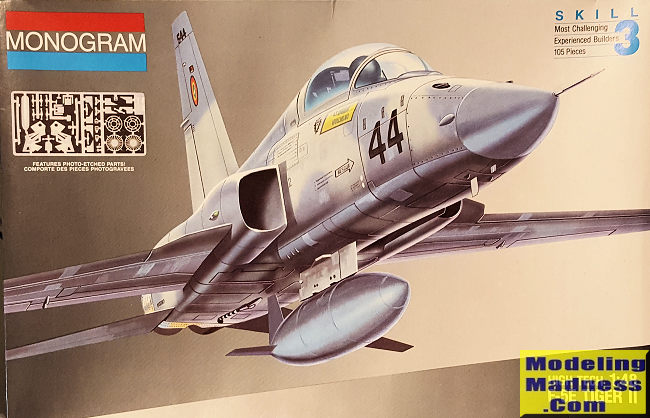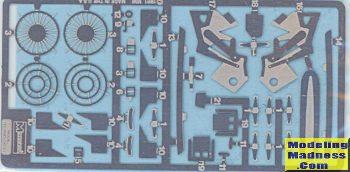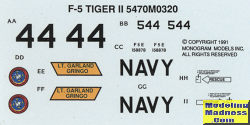
Monogram 1/48 F-5E Tiger II 'Hi Tech'
|
KIT # |
5470 |
|
PRICE: |
$12.00 |
|
DECALS: |
Two aircraft |
|
REVIEWER: |
|
|
NOTES: |
1991 boxing |

|
HISTORY |
The first flight of the F-5E was on 11 August 1972. The first USAF unit to receive the aircraft was the 425th TFS at Williams AFB, Arizona responsible for training foreign pilots in the F-5 aircraft. The most well known use of the "Tiger II" was as an aggressor aircraft at the USAF Fighter Weapons School, Nellis AFB Nevada. The aggressor pilots of the 64th Fighter Weapons Squadron were trained in Soviet tactics and used the -Es to simulate MiG-21s for training USAF pilots in aerial combat skills. Eventually, aggressor squadrons were formed at RAF Alconbury, U.K. and Clark AB, PI for training USAF pilots stationed overseas along with pilots of friendly foreign nations.
The type was also used by the US Navy with its famous TOP GUN adversary school for a number of years. The type was then passed on to the reserves who flew it with VF-126 and other squadrons. When the USAF was forced to trim back its aggressor squadrons in the early 1990s, many of those aircraft were transferred to the Navy who operated them until they reached the end of their airframe life. These were then replaced by ex-Swiss Air Force planes that had been upgraded with extended LEREXs and a 'shark nose' radome.These planes are still being operated with VF-111 in Key West.
|
THE KIT |
 This is a relatively old, but still quite nice kit. This particular boxing is
1978, but it was reissued in 1991. Revell has released a boxing back in 2011.
The kits are not all that difficult to find if you wish one.
The kit is of the raised panel line variety, but is quite accurate despite that
'problem'. The only other kit in this scale before this was by ESCI and hasn't been around
for decades. Those wanting a more modern tooling will gravitate towards the AFV
Club version. The kit is relatively flash free and though there are a few
sink areas, none are terribly difficult to fill. There are ejector pin marks on
the inside of gear doors, on the landing gear, pylons, and other pieces, but
most will be easy to remove.
This is a relatively old, but still quite nice kit. This particular boxing is
1978, but it was reissued in 1991. Revell has released a boxing back in 2011.
The kits are not all that difficult to find if you wish one.
The kit is of the raised panel line variety, but is quite accurate despite that
'problem'. The only other kit in this scale before this was by ESCI and hasn't been around
for decades. Those wanting a more modern tooling will gravitate towards the AFV
Club version. The kit is relatively flash free and though there are a few
sink areas, none are terribly difficult to fill. There are ejector pin marks on
the inside of gear doors, on the landing gear, pylons, and other pieces, but
most will be easy to remove.
In terms of optional bits, well, that is pretty well limited to an RF nose and the ability to have the canopy open or closed. You are also provided a pilot figure, helmet in hand and a boarding ladder. The pylon attachment slots are built into the bottom of the wing so in order to do the option offered on the sheet, these will have to be filled and sanded smooth. Things under wings include two podded guns, two LGBs and two Sidewinders. A centerline fuel tank is also provided. Nice stuff but the F-5E rarely carried the gun pods or the LGBs. The Sidewinders are not well molded so are best replaced.
 What
makes this the 'hi tech' version is the inclusion of a photo etch fret. This
provides rudder pedals, an AOA indicator, lower nose antennas, fins for the
LGBs, additional canopy detail, some levers for the instrument panel,
enhancements for the exhaust, additional bits for the canopy actuators, a fin
tip antenna, pylon anti-sway braces, and rudder pedals. and
What
makes this the 'hi tech' version is the inclusion of a photo etch fret. This
provides rudder pedals, an AOA indicator, lower nose antennas, fins for the
LGBs, additional canopy detail, some levers for the instrument panel,
enhancements for the exhaust, additional bits for the canopy actuators, a fin
tip antenna, pylon anti-sway braces, and rudder pedals. and
 Markings are for
a single aircraft. This is a Top Gun airplane as shown on the box art. This is
in two shades of grey. The decals themselves are well printed, in register, and
a bit on the old side. Most builders will replace them with some aftermarket
ones. Speaking of which, there are a number of aftermarket bits available for
this kit, including a resin cockpit among other goodies.
Markings are for
a single aircraft. This is a Top Gun airplane as shown on the box art. This is
in two shades of grey. The decals themselves are well printed, in register, and
a bit on the old side. Most builders will replace them with some aftermarket
ones. Speaking of which, there are a number of aftermarket bits available for
this kit, including a resin cockpit among other goodies.
|
CONCLUSIONS |
I've built several of these kits over the years. They go together fairly well, but the upper/lower split of the fuselage will require careful construction and filler. Same goes for the intakes. Nothing that most modelers can't handle, but enough to possibly frustrate the tyro or those who only build 'shake and bake' kits.
If you would like your product reviewed fairly and fairly quickly, please contact the editor or see other details in the Note to Contributors.